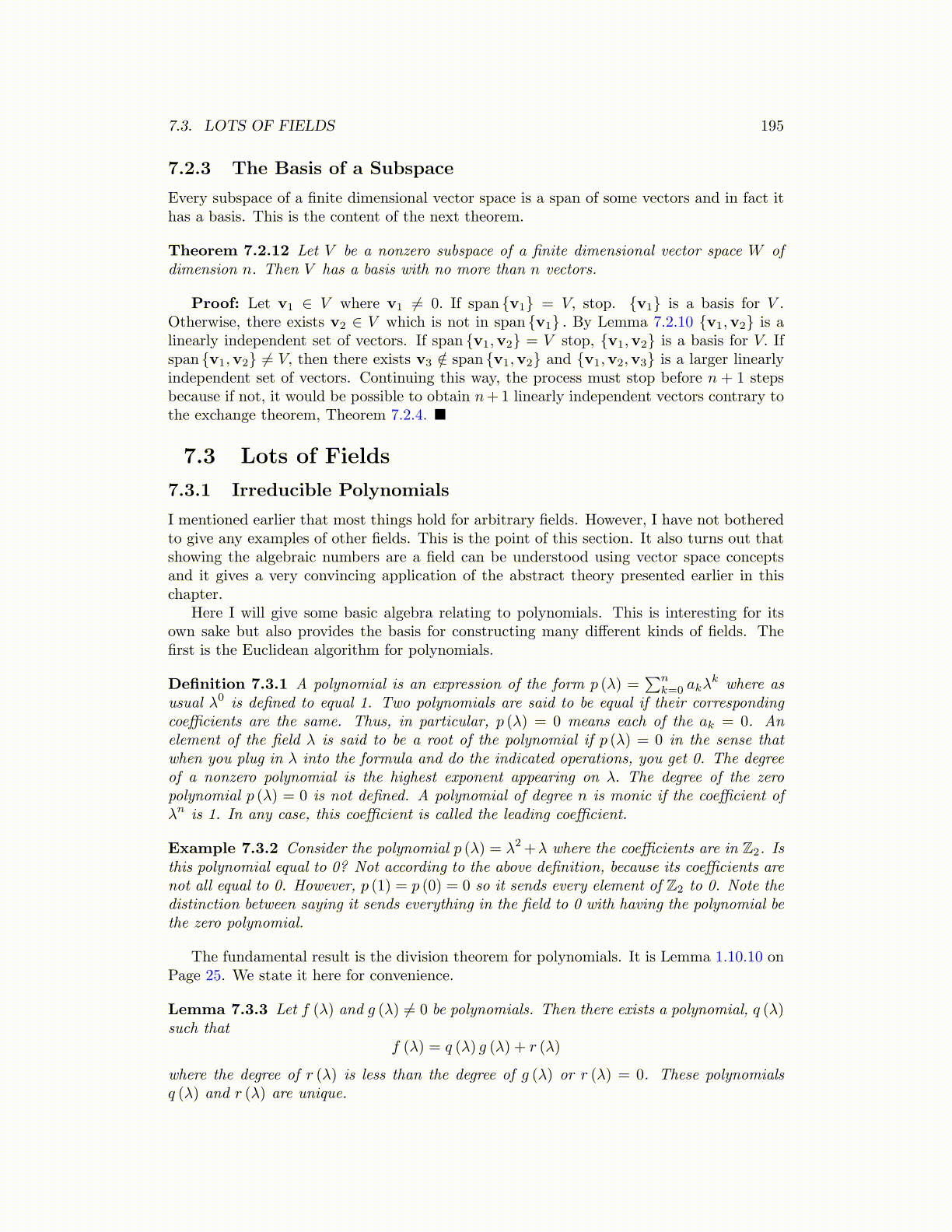
7.3. LOTS OF FIELDS 195
7.2.3 The Basis of a Subspace
Every subspace of a finite dimensional vector space is a span of some vectors and in fact ithas a basis. This is the content of the next theorem.
Theorem 7.2.12 Let V be a nonzero subspace of a finite dimensional vector space W ofdimension n. Then V has a basis with no more than n vectors.
Proof: Let v1 ∈ V where v1 ̸= 0. If span {v1} = V, stop. {v1} is a basis for V .Otherwise, there exists v2 ∈ V which is not in span {v1} . By Lemma 7.2.10 {v1,v2} is alinearly independent set of vectors. If span {v1,v2} = V stop, {v1,v2} is a basis for V. Ifspan {v1,v2} ≠ V, then there exists v3 /∈ span {v1,v2} and {v1,v2,v3} is a larger linearlyindependent set of vectors. Continuing this way, the process must stop before n + 1 stepsbecause if not, it would be possible to obtain n+1 linearly independent vectors contrary tothe exchange theorem, Theorem 7.2.4. ■
7.3 Lots of Fields
7.3.1 Irreducible Polynomials
I mentioned earlier that most things hold for arbitrary fields. However, I have not botheredto give any examples of other fields. This is the point of this section. It also turns out thatshowing the algebraic numbers are a field can be understood using vector space conceptsand it gives a very convincing application of the abstract theory presented earlier in thischapter.
Here I will give some basic algebra relating to polynomials. This is interesting for itsown sake but also provides the basis for constructing many different kinds of fields. Thefirst is the Euclidean algorithm for polynomials.
Definition 7.3.1 A polynomial is an expression of the form p (λ) =∑n
k=0 akλk where as
usual λ0 is defined to equal 1. Two polynomials are said to be equal if their correspondingcoefficients are the same. Thus, in particular, p (λ) = 0 means each of the ak = 0. Anelement of the field λ is said to be a root of the polynomial if p (λ) = 0 in the sense thatwhen you plug in λ into the formula and do the indicated operations, you get 0. The degreeof a nonzero polynomial is the highest exponent appearing on λ. The degree of the zeropolynomial p (λ) = 0 is not defined. A polynomial of degree n is monic if the coefficient ofλn is 1. In any case, this coefficient is called the leading coefficient.
Example 7.3.2 Consider the polynomial p (λ) = λ2+λ where the coefficients are in Z2. Isthis polynomial equal to 0? Not according to the above definition, because its coefficients arenot all equal to 0. However, p (1) = p (0) = 0 so it sends every element of Z2 to 0. Note thedistinction between saying it sends everything in the field to 0 with having the polynomial bethe zero polynomial.
The fundamental result is the division theorem for polynomials. It is Lemma 1.10.10 onPage 25. We state it here for convenience.
Lemma 7.3.3 Let f (λ) and g (λ) ̸= 0 be polynomials. Then there exists a polynomial, q (λ)such that
f (λ) = q (λ) g (λ) + r (λ)
where the degree of r (λ) is less than the degree of g (λ) or r (λ) = 0. These polynomialsq (λ) and r (λ) are unique.